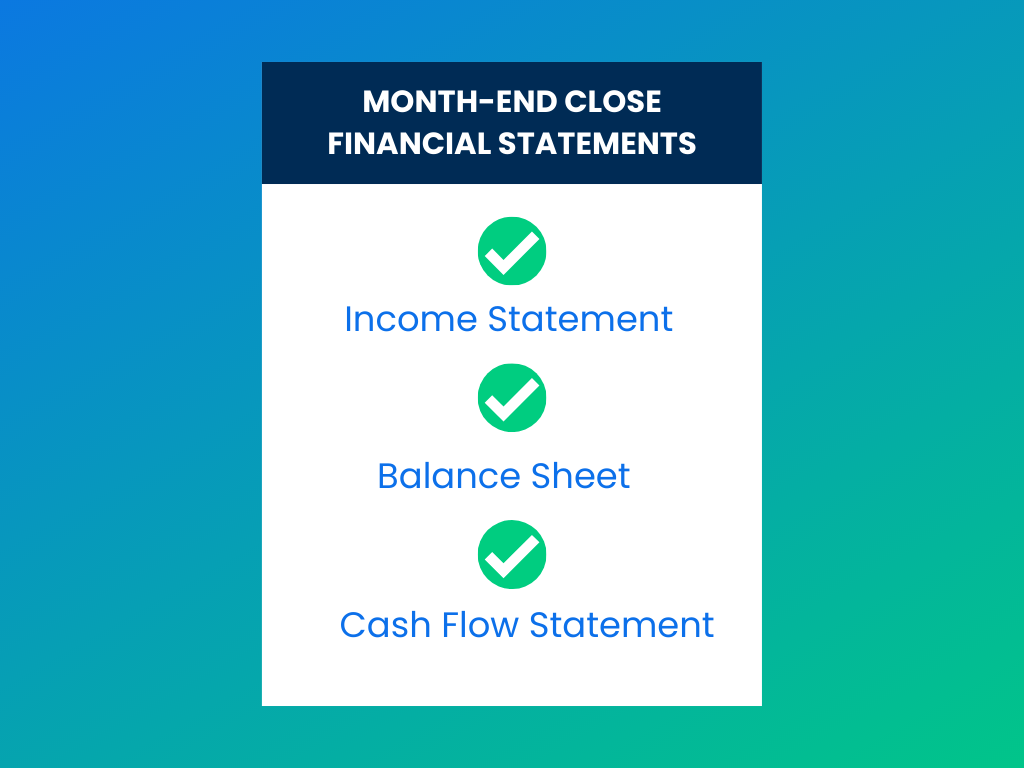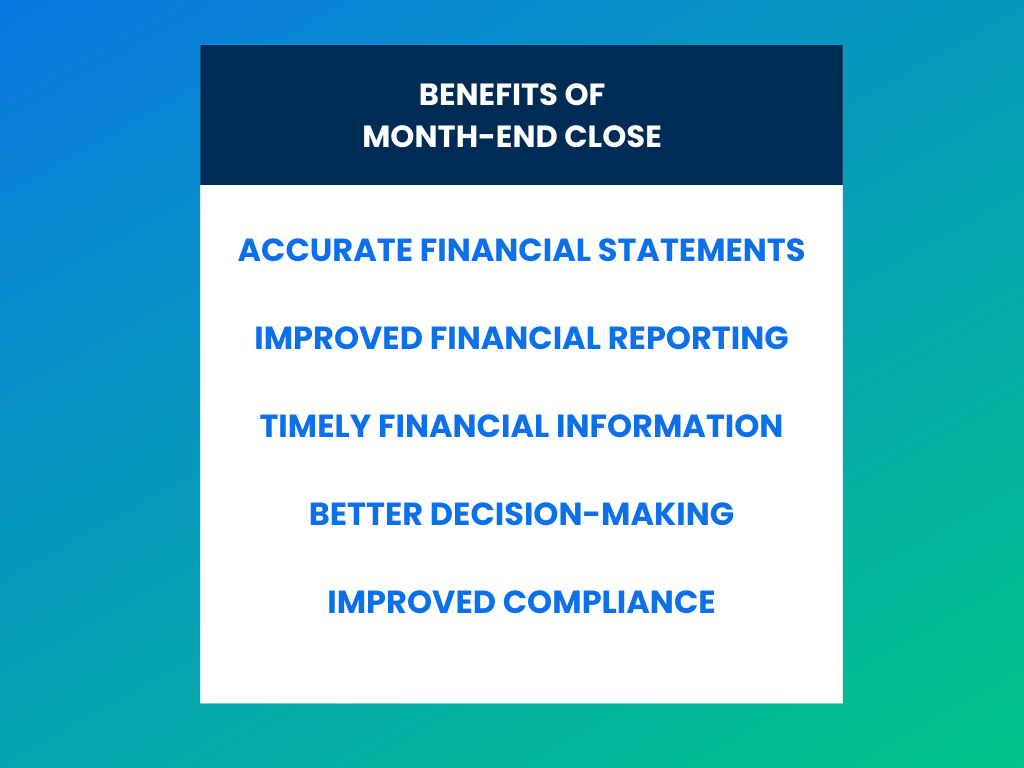Let’s be honest—nobody dreams of the month end close process.
But every finance team knows it’s the backbone of accurate, trustworthy reporting. Without a smooth month-end close, your numbers are off, your reports are delayed, and your confidence in the books? Gone.
The month end close process ensures that every transaction from the past month is properly recorded, every anomaly is flagged, and your financial performance is reflected with precision. It’s not just about ticking boxes—it’s about safeguarding the integrity of your entire accounting cycle.
In this guide, we’ll break down exactly how the month-end close process works, why it matters, and what a well-organized checklist can do to streamline your team’s efforts. Whether you’re looking to tighten controls or just speed things up, you’re in the right place.
What are the 5 key elements of the month-end close?
To make a successful month-end close, accounts from the prior month require reconciliation and all transactions must be posted accurately into company’s financial books and records.
There are various elements included in this process, and to do it you will need the following information:
- Journal Data from General Ledger
- Total Sums of Expenses and Incomes
- Total Revenue
- Cash Fund Amounts
- Fixed Assets
- Data on Inventory
- Bank Account Information
- Balance Sheets
- Financial Statements
The process of period-end closing consists of 5 key steps:
- Record and Review All Accounts
- Reconcile All Accounts
- Prepare Financial Statements
- Close The Period
- Analyze Financial Statements
1) Record and Review All Accounts
This first step is crucial because it’s about setting your numbers straight. Make sure that all journal data is correct, and that all transactions from the period are properly entered into your accounting system.
2) Reconcile All Accounts
Reviewing and reconciling balance sheet accounts ensures that all transactions have been recorded and accounted for. Reconciliation includes bank statements, charge accounts, accounts payable and receivable, fixed assets, deferred revenue accounts, and inventory. This step is important for the accuracy and completeness of the financial statements.
3) Prepare Financial Statements
Financial statements include the income, balance sheet, and cash flow statements. These statements accurately reflect the company’s financial position and the results of financial operations for the month.

4) Close The Period
After all the stages have been accomplished, your month-end closing process is finished and you can officially close the period. This means updating the company’s accounting records to reflect the end of the period and preparing for the next period.
5) Analyze Financial Statements
After the month-end closing process is complete, it is important to review and analyze the financial statements to get an overall view of the company’s financials and to identify any trends or issues. Analyzing financial statements helps management make informed decisions about the company’s financial performance and identify areas for improvement.
The complete month-end close process checklist
| Step | Description |
|---|---|
| 1. Review transactions | Review and reconcile all transactions for the month, including sales, purchases, expenses, payroll, and bank statements. |
| 2. Accrue expenses | Identify any expenses that have been incurred but not yet recorded, and record them in the appropriate accounts. |
| 3. Adjust account balances | Make any necessary adjusting entries to ensure that account balances are accurate and up-to-date. |
| 4. Close temporary accounts | Transfer the balances of temporary accounts (such as revenue and expense accounts) to permanent accounts (such as retained earnings). |
| 5. Generate financial statements | Prepare the balance sheet, income statement, and statement of cash flows for the month. |
| 6. Review financial statements | Review the financial statements for accuracy and completeness, and make any necessary adjustments. |
| 7. Communicate with stakeholders | Share the results of the month-end close process with stakeholders, such as management, shareholders, and board members. |
| 8. Update budget and forecast | Use the results of the month-end close process to update the budget and forecast for the organization. |
| 9. Set the period to closed | Mark the period as closed in the accounting system to prevent any further transactions from being recorded for that month. |
The month-end close process is a series of steps that are taken to ensure the accuracy and completeness of an organization’s financial statements at the end of each accounting period.
The process typically begins with a review of all transactions that have occurred during the month, including sales, purchases, expenses, payroll, and bank statements. Any expenses that have been incurred but not yet recorded are accrued, and any necessary adjusting entries are made to ensure that account balances are accurate and up-to-date.
Temporary accounts, such as revenue and expense accounts, are closed and their balances are transferred to permanent accounts, such as retained earnings. Financial statements, including the balance sheet, income statement, and statement of cash flows, are then generated and reviewed for accuracy.
The results of the month-end close process are then communicated to stakeholders, and the budget and forecast are updated as needed.
Finally, the period is marked as closed in the accounting system to prevent any further transactions from being recorded for that month.
Download your copy of our month-end close checklist
To help you navigate through the month-end close process, you can follow a checklist like the one below:
- Prepare and review the trial balance: This is the first step in the month-end close process. It involves reconciling account balances, reviewing for accuracy, and making any necessary adjustments to prepare for closing out the period’s financial books.
- Journalize adjusting entries: Adjusting entries are created from data that was discovered or changed since the last month-end closing. Accrual accounting requires these journal entries to be made before closing to accurately record current period transactions and revenue. This ensures that all expenses and revenue are recorded in their respective periods, which may not necessarily be when they were paid or received.
- Reconcile balance sheet accounts: Once adjusting journal entries have been posted, all balance sheet accounts need to be reconciled with their respective supporting documents. This includes verifying items such as cash, accounts payable and receivable, inventory, fixed assets, and more.
- Prepare financial statements: After all of the necessary reconciliations are complete, a company can prepare its financial statements for the period ended and present them as a formal report. Financial statements should include an income statement, balance sheet, and cash flow statement at a minimum, but could also include additional schedules depending on the nature of operations such as depreciation schedules or stockholder’s equity movements etc.
- File state and local tax returns if due: Depending on your location, some states may require businesses to file quarterly or monthly tax returns depending on their operations, so it’s important to check with your state governing body for specific guidelines before filing taxes.
- Bank reconciliation and posting transactions: Before closing out a period it’s important to ensure that all transactions have been posted correctly to avoid any discrepancies during future reconciliations or audits down the road. It is recommended that reconciliation of all bank accounts is done before closing each accounting period, as well as any other unrecorded transactions that may still need to be posted before formally closing out the books for a cycle.
- Close sub-ledgers and journals: When all necessary postings have been completed and verified it’s time to close out all sub-ledgers (for example, sales ledger) and journals (general journal). This is done by posting “closing entries” to transfer temporary account balances into permanent ledger accounts for further use in future reporting cycles.
- Review and adjust previous month entries if needed: Review of all journal entries from previous accounting periods can help to ensure accuracy across various reporting cycles, and also allows companies to identify discrepancies quickly in case of an audit investigation.
- Documentation and archiving: The last step in the month-end close process is documenting changes made throughout the entire process along with relevant backup information needed for future references, such as supporting documents used during bank account reconciliations.
Month-end close FAQ
What are the biggest challenges of the month-end close?
Closing out the month’s financial books can be a tedious and often stressful undertaking for an accountant. Many things need to be accounted for, and the process requires accuracy, attention to detail, and precision to ensure that the books are auditable and balanced.
Missing or incorrectly entered transactions can cause all sorts of problems, resulting in costly delays or inaccurate data. Additionally, tracking down various invoices or receipts needed to prepare account statements can be an extra challenge during month-end close.
Common challenges that accounting teams experience during the month-end closing:
- Errors in data entry
- Lack of direction on what needs to be done and/or what is already completed
- Faulty or inadequate data
- No established workflow
- Substantial differences between numbers
- Delayed reconciliations
- No visibility and transparency in the process
What are the benefits of having an optimized monthly closing process?
The main benefits of an optimized monthly closing process include:
- Accurate financial statements
- Improved financial reporting
- Timely financial information
- Better decision-making
- Improved compliance

The monthly closing process provides an organized way to ensure accounting accuracy and efficiency.
The resulting financial reports offer insight into how a business is performing financially and help management spot trends or discrepancies before they become serious issues.
It’s also important for businesses to finalize their financial information at regular periods (monthly or quarterly) to stay compliant with internal policies as well as applicable laws, regulations, and reporting requirements.
How long does the month-end close process usually take?
Depending on the size and complexity of an operation, it can take anywhere from several days to several weeks to complete. If done efficiently, the month-end close process should not take more than a week; however, due to factors like data validation requirements and manual processing steps, some organizations may take longer than others.
Is the month end close process different in NetSuite compared to other systems?
The month-end close process in NetSuite is similar to the process in other accounting systems, such as SAP Business One or QuickBooks. However, there may be some specific differences in the way that the process is carried out, depending on the features and capabilities of the particular system.
For example, NetSuite offers a number of features that can help streamline the month-end close process, such as the ability to automate recurring journal entries and the option to customize financial reports. Additionally, NetSuite’s period close dashboard provides an overview of the progress of the close process and alerts users to any issues that need to be addressed.
In general, the month-end close process in NetSuite involves reviewing and reconciling all transactions for the month, making any necessary adjusting entries, generating financial statements, reviewing the statements for accuracy, and communicating with stakeholders. The period is then marked as closed to prevent any further transactions from being recorded for that month.
It is important to note that while there may be some differences in the way the month-end close process is carried out in different accounting systems, the overall goal is the same: to ensure the accuracy and completeness of the organization’s financial statements at the end of each accounting period.
How can you speed up your month-end close?
To get started, take a step back and thoroughly evaluate existing close procedures. Analyze the process itself, and note where resources can be allocated more efficiently. Automate what you can and make sure that all team members have an accurate list of their responsibilities – this will help curb any confusion or missed deadlines.
Taking these simple steps before starting your month-end close process will help to ensure its success.





